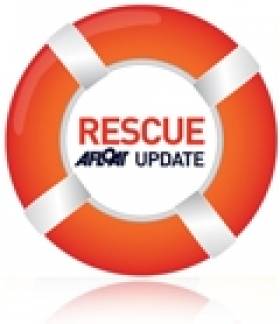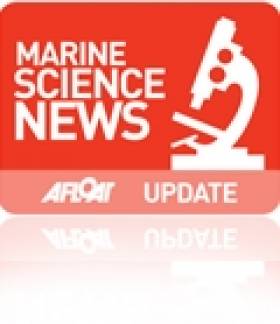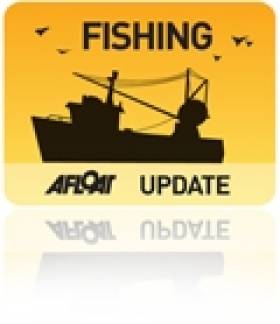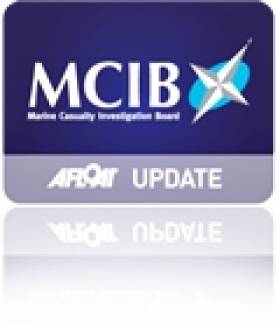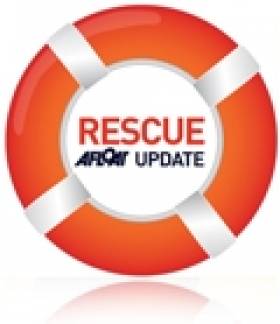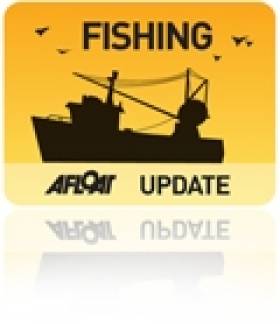Displaying items by tag: Fishing
Second Russian Fishing Vessel In A Week Requires Medevac
#Rescue - Irish Coast Guard helicopter Rescue 115 was dispatched yesterday morning (18 February) for a medevac of an injured fisherman.
As the Irish Independent reports, the casualty was on a Russian fishing vessel some 200 miles off the southwest coast, heading towards Castletownbere.
The operation comes just a week after another Russian crewman was airlifted from a factory ship off Cork after sustaining a hand injury.
The latest incident is believed to relate to a bleeding ulcer, and the casualty was expected to be transferred to the mainland for treatment by yesterday afternoon.
New Project Uses Seabed Mapping To Study Behaviour Of Fish
#MarineScience - Ciaran O’Donnell, a specialist in fisheries acoustic research with Fisheries Ecosystem Advisory services at the Marine Institute, has just begun a PhD research project that will link fisheries and seabed mapping acoustic technologies.
By using both technologies, he aims to learn more about how fish behave during acoustic surveys and therefore increase the precision of fish stock assessments.
O’Donnell’s research will focus on pelagic species – fish that swim in the water column – to see if there is avoidance behaviour during acoustic surveys and also to look at schooling behaviour and preferred habitat.
He’ll use the state-of-the-art multibeam echosounder system that has just been installed on the RV Celtic Explorer to look beyond the data normally captured during acoustic fisheries surveys to see if some or any of the fish being targeted by the survey are moving away from the research vessel as it passes overhead them.
“I’m really looking forward to the sea trials of the new multibeam next week (16-24 February) when we’ll get a chance to use the most advanced seabed mapping technology alongside acoustic fisheries technology. We should be able to see a much broader picture than before," said O'Donnell, a chief scientist on annual surveys for blue whiting, Celtic Sea herring and boarfish.
“Acoustic surveys are very targeted and focussed and this will allow us to capture new information about what the fish are doing beyond the target of the downward-looking fisheries echosounder. It will be like getting enhanced peripheral vision of the sea around the ship.
“We’ll be able to see if fish are moving away from the research vessel and out of the survey path and therefore will potentially enhance the precision of our current survey methods.”
The project will bring together technology and data from fisheries and seabed mapping and O’Donnell will work closely with the INFOMAR team and the advanced mapping services at the Marine Institute.
The research project, originally designed by the INFOMAR team, brings together a number of experienced researchers including Dr Chris McGonigle and Dr Rory Quinn of the University of Ulster, Dr Fabio Sacchetti of INFOMAR and the Marine Institute, and Dr David Reid of the Marine Institute and UCC.
Galway Skipper Expo 2015 Set To Be Biggest & Best Yet
#Fishing - Over 110 companies will be exhibiting at Skipper Expo International Galway 2015 on 6-7 March.
This is the event's biggest exhibitor attendance ever – and organisers say it's confirmation of the important place the flagship fisheries show holds in the industry calendar.
Sponsored by Bord Iascaigh Mhara (BIM), this year’s 11th anniversary Galway event in Ireland is shaping up to be the best yet, thanks to the huge amount of interest from both exhibitors and visitors from all over Ireland, the UK and beyond.
Indeed, such has been the demand for stand space that two additional rooms have been secured at the event venue at the Galway Bay Hotel to accommodate this extra surge in interest.
Star attractions will include boat displays, pool demos and the superb exhibitors’ seafood buffet. There will be something to interest every visitor, thanks to the vast range equipment and service suppliers covering all sectors of the fishing industry.
Sharon Boyle of show organisers Mara Media said: “We have been overwhelmed by the huge interest in Skipper Expo International Galway 2015 and it promises to be a fantastic event. The record number of exhibitors underlines the dynamism and innovation that lies at the heart of our fishing industry.”
Skipper Expo 2015 opens on Friday 6 March at 10am running till 5pm, continuing on Saturday 7 March from 10am to 4pm. Admission is free, and more details can be found at the Mara Media website HERE.
Series Of Safety Breaches Led To Loss Of Three Lives In Tramore Bay Capsize - MCIB
#MCIB - Lack of adherence to water safety procedures led to the drowning of three fishermen off Waterford in the summer of 2013, according to marine investigators.
As previously reported on Afloat.ie, three bodies were recovered from the waters of Tramore Bay after a search for a missing fishing punt on the evening of 12 June 2013.
They were later named locally as brothers Paul, Shane and Kenny Bolger, all aged in their 40s.
Dunmore East RNLI coxswain Michael Griffin commented that the tragedy was "a devastating loss for the community."
He added: "I knew the men personally and had been at school with two of them. They were well known and respected by everyone."
The Marine Casualty Investigation Board's (MCIB) report into the fatal incident involving the MFV Dean Leanne, published this week, has found that a series of safety breaches contributed to the loss of the three men's lives.
Their small open vessel – which was rated to carry only two crew, and did not carry a valid Declaration of Comlpliance with the Fishery Vessel Safety Code of Practice – had headed out before 7am on the day to tend to lobster pots between Falskirt Rock and Brownstown Head.
This was in an area where the boat was not certified to operate, and where the sea conditions grew worse as the day progressed. The brothers had also not provided details of their trip with anyone ashore.
The fibreglassed exterior of the vessel was noted to be in poor condition with "extensive rot and decay" that would result in "reduced structural integrity" - putting boat and crew at risk as the swell built up.
Though it cannot be established exactly how the vessel came to capsize and throw the three overboard, it's believed whatever happened "occurred very quickly as no MAYDAY was transmitted by VHF radio or flares."
Two of the three men were found to be wearing personal flotation devices (PFDs) though only one of these was of the automatic hydrostatic release type, the other being manually operated and found still in its protective cover.
Both PFDs were also poorly maintained, with leaks in their air bladders.
The boat's EPIRB device, meanwhile, did not emit a signal to emergency services despite being found to have been manually operated, and subsequently coming into contact with water.
It was later found to have a defective microprocessor, and was one of a number of models for which its manufacturer later issued a recall notice, though family of the deceased confirm the handset was tested in the month before the incident.
The full MCIB report on the MFV Dean Leanne is available to download HERE.
Airlift For Russian Fisherman With Hand Injury
#Rescue - The Irish Times reports that a Russian fisherman is in hospital after sustaining serious hand injuries on a factory ship off Cork.
The man was airlifted from the Starry Arabat some 320km west of Slea Head yesterday morning (Tuesday 10 February) by the Shannon-based Irish Coast Guard helicopter Rescue 115.
By evening he had been transferred to Cork University Hospital for emergency surgery to save his hand.
The circumstances of the injury are not yet known, but The Irish Times has more on the story HERE.
New Tech Puts 'Eyes On The Seas' To Curb Fishing Pirates
#Fishing - Who's watching out for illegal fishing in the world's oceans? It could be anyone at the click of a mouse of the tap of a touchscreen – if a new satellite tracking programme takes off.
NPR's The Salt blog reports on the Eyes on the Seas project, that aims to help authorities the world over keep tabs on illegal fishing activity via a 'virtual watch room' that combines satellite imagery with real-time location data.
The inspiration for the project is the recently launched Global Fishing Watch system. As reported on Afloat.ie last November, this uses specialised software from a small start-up called SkyTruth, which maps AIS data onto satellite maps of the oceans to track the activity of fishing fleets around the world.
The project has the backing of internet giant Google, and now SkyTruth's John Amos has partnered with the Pew Charitable Trusts on the latest version of the initiative to use technology against the ocean's seafood pirates.
NPR has much more on the story HERE.
Two Men Convicted for Illegal Fishing on Lough Corrib
#illegalfishing – At a sitting of Galway District Court on Tuesday, 3rd February, Judge Denis McLaughlin convicted two men of illegal fishing, and issued fines and costs totalling €1,850. Michael Gannon of Raleigh Row, Galway City, and Brendan Hardiman, with an address at Mace, Corrandulla, Co. Galway were both in court on charges of the illegal use of a net, and illegal possession of a net in contravention of the 1959 Fisheries Act.
Judge McLaughlin heard evidence that on the night of 6th July 2014, fisheries officers on patrol observed the men in a boat on Lough Corrib setting a net. The men returned to shore and left the scene. At approximately 2 am on the 7th July the men returned to the lake, rowed out and retrieved the net. On return to shore they were challenged by the fisheries officers, and under caution they admitted the offences.
Both men were convicted by Judge McLaughlin on one count, with the second charge taken into account. It was acknowledged that on the night both defendants had been co-operative, had accepted responsibility for their actions and were pleading guilty to the charges. The judge heard that Mr. Hardiman had two previous convictions for similar offences, and he fined Mr. Hardiman €750, with €300 costs. Mr. Gannon was fined €500 with €300 costs.
Inland Fisheries Ireland (IFI) has a confidential hotline number to enable members of the general public to report incidents - 1890 34 74 24 or 1890 FISH 24. This phone line is designed to encourage the reporting of incidents of illegal fishing, water pollution and invasive species.
Bodies Found In Search For Missing Trawler In English Channel
#Missing - BBC News reports that two bodies have been recovered from the sea in the search for four fishermen whose trawler went missing in the English channel this week.
Lifeboat crews from Dungeness, Dover and Hastings RNLI stations yesterday (29 January) resumed their part in a major search for the Belgian fishing boat, which vanished from radio contact on Wednesday (28 January) some 10 miles south of Dungeness.
They joined search and rescue helicopters, vessels from the French authorities, a Trinity House boat and several other fishing trawlers in what was expected to be "a long, protracted search of the channel", according to RNLI divisional operations manager Allen Head.
At 3pm yesterday debris was identified 20 miles southeast of Dungeness, in French territorial waters, and the lifeboats continued to search the area until they were recalled by the coastguard.
However later in the evening two bodies were discovered in the sea off Boulogne in northern France, some 30 miles across the channel from Dungeness. BBC News has more on the story HERE.
Video Shows Shocking Moment As Aran Islands Trawler Disappears Under Scottish Waves
#Rescue - Mail Online has more on the dramatic rescue of Aran Islands fishermen from an Irish trawler that sank off Scotland's Outer Hebrides last week.
As previously reported on Afloat.ie, three of the five crew were airlifted to hospital with suspected hypothermia after the Iúda Naofa began taking on water some 48 miles off Lewis in the far north-west of Scotland.
But new video from HM Coastguard shows the shocking moment as the crew escaped their trawler just before it disappeared beneath the waves in a mere 35 seconds.
Minutes beforehand, coastguard crew members had attempted to clear the water from the boat with a salvage pump but the vessel was quickly overwhelmed.
Micheál Ó Conghaíle, a deckhand on the boat skippered by his father Mairtín, describes how what was a normal fishing expedition went south after the rough waters "got the better" of their pumps.
Yet he and the rest of the crew are thankful for getting out relatively unscathed just weeks after the loss of eight crew on a cargo ship in the Pentland Firth.
Mail Online has much more on the story HERE.
Medevac For Skipper Of Trawler Off Dingle
#Fishing - A fisherman with a suspected case of appendicitis was airlifted from a trawler off Dingle yesterday, as the Irish Independent reports.
Valentia coastguard co-ordinated the medevac of the skipper of the fishing vessel Ellie Adhamh, which was some 120 miles off the Kerry coast when be took ill.
The rest of the trawler's seven-man crew were expected to return to port in Castletownbere in West Cork this morning.


























